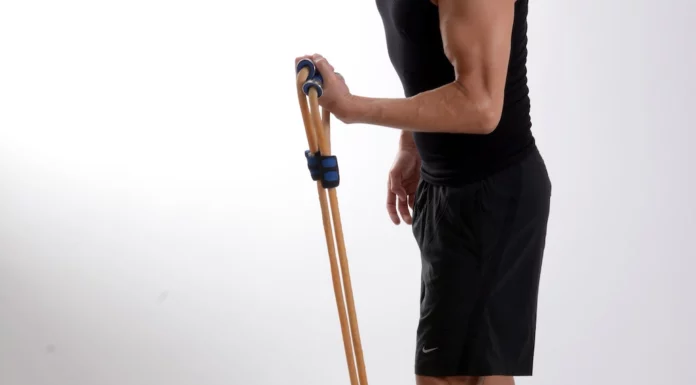Before investing in any gym gear or equipment, it’s essential to take an objective look into the pros and cons of the product. Resistance bands are no different. They can help intermediate and advanced lifters break massive personal records(PRs) but can be a danger and a nuisance if misused.
What are Powerlifting Resistance Bands?
Powerlifting resistance bands are long, circular, elastic bands that accommodate a powerlifter’s resistance training regimen. They are giant rubber bands, using stored energy to resist the bar’s motion.
Do Resistance Bands Build Muscle?
Powerlifting resistance bands are one of the most effective methods of augmenting your weight-lifting regimen. Not only have lifters of all shapes and sizes used them for over 20 years, but scientists agree that the resistance used for muscle growth does not need to be weight. The body can’t distinguish the mechanism providing muscle tension, only the amount, direction, duration, and such. This means that using bands alone, or especially in combination with weights, can significantly boost the muscle-building program you follow.
How are Resistance Bands Used?
There are several ways to attach a band for powerlifting properly. There is a standard straight band position that can work for squats. However, the band will usually go utterly slack before the bottom and can quickly come out of position. You can choke them around themselves at the bottom, either around pins or the horizontal bar of your rack. This will give them enough tension to stay in position throughout a squat. You can also double them up, adding much more resistance. You will almost always use them on the bench press in a doubled-up position. Deadlifts usually require bands to be used on pins across the bar, front to back. They can be either singled or doubled up.
Pros and Cons of Resistance Bands for Powerlifters
Pros
- The resistance matches the strength curve
- Easier to carry than chains
- It is cheaper than buying additional weights
- Can help break a plateau
Cons
- May be tough to set up properly
- Have a tendency to snap if placed on the knurling
- Are confusing and come in many colors and sizes
Benefits of Resistance Bands
Catering to the Strength Curve
Typically, during any of the three power lifts, a lifter will be the strongest at the top of the lift and weaker at the bottom. A band that adds resistance to a lift will have a resistance profile that matches this strength profile. It will feel the heaviest at the very top of the lift and lighter as you move down to the bottom. This can help a lifter create explosiveness and improve their lockout.
Lighter and Smaller than Chains
Sometimes powerlifters will use chains as a form of accommodating resistance. They work well, but as they work through the mechanism of weight, they can be challenging to transport. It’s strongly recommended that the chains be left at the gym, while bands can be available in the gym or carried easily in a gym bag. Since the resistance they add comes from the stretch of the bands and not their weight, they’re a much more portable form of accommodating resistance.
Inexpensive in Cost
Compared to other methods of increasing your resistance, bands are relatively inexpensive. If you work out at a home gym and have found yourself unable to load up the amount of weight you can squat for three heavy reps, your first thought may be that you need more plates. However, if you have just a pair of small red Rogue bands, you can accomplish at least 100 pounds of extra resistance at the top of the lift by doubling them up. This can cost as little as $24 before shipping and is much cheaper than $1/pound or $2/pound, which you’ll commonly spend on plates. They’re also much lighter and, therefore, cheaper to ship. This isn’t to say you should replace weight with bands, but for most of your training, you can use bands to accomplish the same amount of resistance on a tighter budget.
Plateau Breaking Capabilities
Some very powerful lifters have repeated time and time that when they hit a stopping point in their training, bands have helped them break through it. It happens to everyone; for a while, you’re hitting a five or 10-pound PR every month until suddenly you feel like you stopped getting stronger. Well, since the resistance of a band increases on the way up, it’s almost like a weight that gets heavier the further you push it away from the Earth.
It’s as if Earth’s acceleration on the weight is increasing throughout the lift. This forces you to be in a tight position and lift explosively, which has a massive impact on your bar speed when you go back to lifting unaccommodated weights.
Drawbacks of Resistance Bands
They Need to Be Properly Positioned
As detailed above, there are several ways to attach a resistance band properly, which can be challenging to remember. When you find a setup that works well for you, take a picture so you can replicate it later. It’s important to remember that the band should be completely vertical in the position you’ll have the bar throughout the lift, not where it is when racked. If the band is too far forward or backward, it can pull a weight off your back or pull the bar towards your head and generally cause you to get hurt.
Another way of properly using a band is to do a reverse band, which will lighten the load the most at the bottom and leave you to deal with more of the load at the top. This will require more weight than the other way for the same resistance, but it will match the strength curve of the lifter just as well.
Knurling is Their Kryptonite
Don’t place the bands on your bar on a section with knurling. Many lifters will put the band just inside the weights on the thicker portion of the bar on the end. However, you can put it on the inside section if the bar you’re using lacks knurling there.
Be sure not to place them on the knurling because it will snap your bands much more quickly than normal wear and tear.
They’re Confusing
There are so many colors and sizes of resistance bands to choose from that it can be difficult to know where to start. An excellent place to start is to get a pair of red mini bands, which are about a half-inch wide, and a pair of green light bands over an inch in width. These are the colors offered by Rogue Fitness, so it’s a good idea to check and see the colors for a different brand if you’re going with somebody else.
The critical thing is anything stronger than the green light bands will be extremely powerful. They will only be helpful if you’re a big squatter, lifting something like 500 to 600 pounds or more.
Which Powerlifting Bands Should You Choose?
One of the most widely touted brands of resistance bands is Rogue Fitness. They offer many different colors and sizes of bands, and it’s easy to tack them onto an order of weights, racks, barbells, dumbbells, belts, or practically any other piece of gym equipment or gear.
If you’re just getting started with resistance bands, it’s recommended that you stay away from the heaviest types as they won’t be beneficial for you at all. You should be capable of lifting at least 250 pounds on a lift before using the small red bands or 500 before you move up past the green light bands.
Most beginner and intermediate lifters fall between those two categories, so it’d be a good bet to start with just red and green to see how you like them.
Conclusion
Resistance bands are an excellent way for powerlifters to add resistance to the tops of their lifts and change things up in the gym. They can build muscle just as well as weight but match the strength curve of the lifter much better.
Also, they’re light and easy to transport, reducing costs and making them easy to stick in your gym bag. They need some care to be correctly positioned and can be confusing or difficult to use. They’re also prone to breaking if misused and can be dangerous if they snap or pull the bar in the wrong direction. It’s also hard to tell which ones will be the best for you.
However, with thorough research and education about the bands, you can alleviate these issues, and the benefits will shine through. Good luck breaking those PRs!


